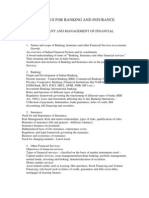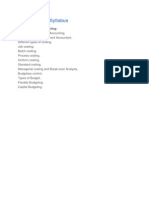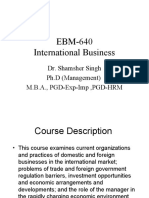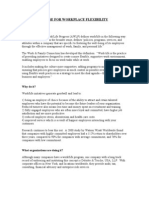Tybms Sem 6 Syllabus
Tybms Sem 6 Syllabus
Uploaded by
Ravi KrishnanCopyright:
Available Formats
Tybms Sem 6 Syllabus
Tybms Sem 6 Syllabus
Uploaded by
Ravi KrishnanOriginal Description:
Copyright
Available Formats
Share this document
Did you find this document useful?
Is this content inappropriate?
Copyright:
Available Formats
Tybms Sem 6 Syllabus
Tybms Sem 6 Syllabus
Uploaded by
Ravi KrishnanCopyright:
Available Formats
TYBMS SEM 6 Syllabus
Entrepreneurship and Management of Small and Medium EnterprisesI) Concept, meaning and definition of entrepreneur and entrepreneurship. Importance and significance of growth of entrepreneurial activity. Concept of intrapreneur. Characteristics and qualities of entrepreneurs Classification and types of entrepreneurs. Women entrepreneurs Theories of entrepreneurship Contribution of Mc Clelland and Joseph Schumpeter II) Factors influencing entrepreneurial development and motivation. Role of culture in entrepreneurial development. Entrepreneurial development programme (EDP), Managing the problems faced by entrepreneurs Development of women entrepreneurs-with reference to SHGs Options available to entrepreneurs,-ancillarisation franchising and outsourcing. Cases on takeover, mergers and acquisitions in India and at global level. Social Entrepreneurship-Definition,importance and social responsibilitiesNGOs III) Entrepreneurial Project Development Idea generation sources and methods Identification and classification of ideas. Environmental Scanning and SWOT analysis Preparation of project plan Points to be considered Components of an ideal business plan market plan, financial plan, operational plan, and HR plan. Project formulation project report significance and contents Project appraisal Aspects and methods : (a) Economic oriented appraisal (b) Financial appraisal (c) Market oriented appraisal Technological feasibility Managerial competency IV) Small and Medium Enterprises : Meaning and definition (evolution) Role and importance
Policies governing SMEs Organisational structure Steps in setting up a small unit SME funding. Requirements of capital (fixed and working), Factors determining capital requirements, Importance of fixed and working capital, Working capital management, Sources of finance for SMEs, Taxation benefits SIDBI and SISI Their role in the development of SMEs Marketing mechanism in SMEs. Export potential of SMEs Problems of SMEs and prospects Turnaround strategies for SMEs OPERATIONS RESEARCH I) Introduction to OR and Linear Programming Operations Research Introduction, Models, Areas of Application. Linear Programming (L.P): Mathematical Formulation of L.P. problem. Graphical Method. Simplex Method Concept of slack, surplus & artificial variables. Manual solutions of L.P.P. upto 3 iterations. Minimization & Maximization Problems. Special Cases (i) Alternative optima (ii) Unbounded solutions & (iii) Infeasible solutions to be shown graphically & also by simplex method. II) Transportation & Assignment Models Definition of the transportation model. Balanced / Unbalanced, Minimisation / Maximisation. Determination of the initial basic feasible solution using (i) North-West Corner Rule (ii) Least cost method & (iii) Vogels approximation method for balanced & unbalanced transportation problems. Optimality Test & obtaining of optimal solution. (Considering per unit transportation cost) Assignment Problem Hungarian method. Statement of Transportation & Assignment Problems as L.P. Problems. III Network Analysis Construction of Network Rules & precautions. C.P.M. & P.E.R.T. Networks. Obtaining of Critical Path. Time estimates for activities. Probability of completion of project. Determination of floats (total, free, independent & interfering) Crashing of Simple networks.
IV Decision Theory And Decision Tree Decision Environments risk & uncertainty. Payoff table, Regret table. Decision making under uncertainty Maximin & maximax criteria Minimax Regret criterion Laplace criterion Hurwicz criterion Expected Monetary Value criterion. Expected Value of Perfect Information (E.V.P.I) Expected Opportunity Loss (E.O.L). Decision Tree (Simple examples) INTERNATIONAL FINANCE I) Fundamentals of International Finance Meaning and Scope of International Finance Balance of payments as determinant of demand for and supply of currency Exchange rate, Determinants of/factors affecting exchange rate s Current account deficit v/s Balance of trade and their implications on exchange rate Foreign Exchange Arithmetic I Exchange rate quotations, Direct and Indirect rates, cross currency rates, vehicle currency. % spread, calculation of cross rates Classification of rates in terms of settlement (cash, tom, spot and forward), Arbitrage, Speculation and Trading (Spot rate arbitrage calculation) II) Foreign Exchange Arithmetic II Relationship between exchange rates, interest rates, and commodity pric es (through international parity conditions namely Purchasing Power Parity, and Fisher Parity) Use of Covered Interest Parity theory in arbitrage, borrowing and investment decisions. Calculation of forward rates through use of forward schedules, through use of formula, annualized forward margin, calculation of swap points (calculations for cash / tom rates to be excluded) Exchange Rate Regimes Gold Standard Features. Bretton Woods System Background and Features, reasons for its failure, Smithsonian agreement, SDRs. Flexible exchange rate system Features, Managed float, Central Bank
intervention. Merits and Demerits of Fixed and Flexible Exchange rate systems III) International Foreign Exchange Markets Characteristics Dealing room operations Euro Currency Market Origin and reasons for the growth of Euro currency (off shore) markets, their characteristics and components. A brief understanding of the Euro-currency deposit, loans, bonds and notes market. Concept of off shore banking as a form of globalization of the Euro currency concept, its introduction in India, tax havens International Equity Markets Concept of Depository Receipt, Global Depository Receipt- characteristics, mechanism of issue, participants involved American Depository Receipt types and characteristics Foreign Currency Convertible Bonds and Foreign Currency Exchangeable Bonds Foreign Direct Investment and Foreign Portfolio Investment Participatory notes IV Foreign Exchange Management in India Retail and Wholesale components of the Indian foreign exchange market Capital account Convertibility Reserve Management Role of FEDAI in the Indian foreign exchange market. Risk Management And Derivatives: Risk versus exposure Transaction, Translation and Economic risks faced by Corporate entities Transaction, Position, Pre-settlement, Settlement risks faced by commercial banks Internal and external hedging Foreign currency derivatives as instruments of risk management i.e. Forward contracts, Swaps, Futures and Options. Overview of Non-deliverable forward Market (NDF market) International Institutions Contribution of Bank for International Settlements in risk management system European Central Bank
INDIAN MANAGEMENT THOUGHTS AND PRACTICES I) Indian Ethos Multiplicity and variety yet has commonness Focus on the ultimate Principle or Intelligence to whom (or which) man seeks recourse. II) Personality Personality development through yoga the three paths/marga bhakti, karma and Jnana The three gunas sattva, rajas, tamas. Individual a being with infinite capabilities and potentials is a result of your own actions Koshas: the concept of man Meditation the technique for development of self Leadership: qualities of leaders with special reference to Indian thoughts. Motivation Indian approach vis--vis American and Japanese approaches. III) Society and Social Groups: Society combination of individuals of diversity values that reflect on social practices and customs impact on individual and collective behaviors uses coercion to enforce compliance societal values. Significance of festivals harmony with nature. Indian concept of learning gurukul system of learning. IV) Spirituality: The core teachings of all founders of religions. Spirituality vis--vis religion Concept of Maya (Illusion) Advaita Vedanta Meaning, scope and implications at work Concept of Dharma: varna ashram dharma, svadharma Concept of karma meaning and importance to managers, corporate karma. Concept of Vasudhaiva Kutumbakam INTERNATIONAL MARKETING I) Introduction Definition of international marketing-important features of international marketing-need for & advantages of international marketing-difference between international & domestic marketing,
Basis of International trade. International Business Environment External factors: Social/ Demographic/ Economic/ Commercial/ Political & legal- Trade Barriers, meaning, Objectives, effect of barriers on international trade, Types of barriers: Tariff & non Tariff barriers- Trading Blocs & Growing intra regional trade- WTO & trade liberalization-latest developments at WTO including Doha RoundRole of MNCs in International trade, FDI II) Product Packaging and Distribution Packaging as a part of product planning- Functions of packagingFactors for package design in international markets- Criteria for export packing (transport packing) role of Indian Institute of packaging- Export marking on outer packing- Purpose of export marking , selection of overseas distribution channels, factors influencing selection of distribution channels, types of foreign intermediaries. III) Pricing Policy in International Markets Factors determining price- Export costing methods- Elements of costFactors influencing pricing policy- Information required for export pricing- Export pricing strategies- Break even pricing- Impact of contract conditions on export price offers- INCOTERMS- Export assistances, incentives, Govt. of Indias initiatives- Impact of export incentives on export pricing. IV) Overseas Market Selection Methods of market entry, Identifying foreign markets, selecting potential markets- Constraints in entering in some global territoriesMarket selection process- Objectives entering into international markets- Setting parameters, preliminary screening of the probable markets- sources of information- Short listing of markets, evaluation & selection of potential markets- Market segmentation based on overall market profile, Basis for segmentation, Factors for segment selection, essential characteristics of market segments- Preference available to Indian exporters. RETAIL MANAGEMENT (ELECTIVE PAPER) I) Introduction: Meaning & Definition on retailing Retailers role in a distributional channel functions performed by retailers- prospects of retailing in India-
Retailers characteristics price-cost trade off, types of merchandise, variety & assortment, customer services, cost of offering breadth & depth of merchandise and services Types of retailers food retailers, general merchandise retailers, non store retail formats, services retailing, types of ownership Multi Channel Retailing meaning, the evolution toward multi channel retailingFranchising types, advantages, challenges, franchising in India. II Retailing strategy Meaning Retail Market Strategy target market & retail format building a sustainable competitive advantage, customer loyalty, location, human resource management, distribution and information systems, unique merchandise, vendor relations Multiple sources of advantages strategic retail planning process Role of Information Technology in retailing III Merchandise Management meaning, organizing the buying process by categories setting objectives for the merchandise plan sales forecasting, the assortment planning process Buying merchandise branding options available to retailers private labeling, international sourcing decisions pricing strategy Price Adjustments meaning of terms like markdowns, coupons, rebates, price bundling, multiple unit pricing, variable pricing IV) Store Management responsibilities of store managers store planning, location planning store design & the retail image mix, the space mix
effective retail space management, store layout, floor space management and visual merchandising and displays INVESTMENT ANALYSIS AND PORTFOLIO MANAGEMENT (ELECTIVE PAPER) I) Introduction Meaning of Investment Investment alternatives, Investment Avenues Meaning of Portfolio What is Portfolio Management Objectives, Principles of Portfolio construction. Investment Alternatives Non Marketable Financial Assets Bonds or fixed Income securities Equity shares Mutual Funds Schemes of mutual funds (only concept of equity scheme, Hybrid Scheme, Debt Scheme) Calculation of Net Assets Value (only Basic problem) Evaluation of portfolio performances Securities Market Primary Equity Market, IPO, Book Building Process, Redherring Prospectus. Secondary Market Stock Markets, Trading & Settlement -Debt Market Role of SEBI II) Time Value of Money Present Value Future Value Present Value of Annuity Future Value of annuity (compounding & discounting factors concepts and simple problems based on it) III (i) Risk & Return Meaning and Types of Returns Holding Period return Expected return Annualized return measurement of return Risk Types of Risk Measurement of Risk (ii) Fundamental and technical analysis IV Equity & Debenture Valuation Equity: Balance Sheet Valuation Dividend Discount Model zero growth constant growth multiple growth model price earnings ratio model Debentures: Debt Instruments Bond valuation & Pricing Yield to maturity (YTM), Interest Rate Risk Determinants of Interest Rate Risk.
ECONOMETRICS(Elective Paper) I) Introduction to Econometrics methods and models Definition and scopeNature of Econometric Approach Methodology of Econometric research Specification of the models Estimation of the Parameters of the Model Evaluation of the Estimates Evaluation of the Forecasting Ability of the Model Desirable properties of an Econometric Model. Types of Models: Single Equation models with one and two explanatory variables. Properties of OLS estimators. Co-efficient of determination of goodness of fit Tests of significance of Alpha & Beta Analysis of Variance and regression analysis II Problems associated with the models- autocorrelation, Multicollinearity and heteroscedasticity. Simultaneous equations models Types of models, identification, method to solve them ILS and 2SLS. Simple Correlation and regression (In the form of revision) Partial correlation Estimation of Partial Regression Co-efficient and Co-efficient of Partial correlation. III Input-Output Analysis The Inter-industry Accounting System The Input Output table Balance equations Input Output co-efficient The Hawkins Simon conditions Prices in Leontief Input Output system. Assumptions of Input Output analysis Validity of Input Output assumptions. Closed Model Comparison with Leontiefs o pen static system IV Game Theory Introduction Basic concepts in Game Theory Solutions to Two Person Zero sum Game Games with saddle point (Pure Strategies) Games without saddle point (Mixed Strategies) Graphical Solution (2x2game, 2xm, mx2 game)
You might also like
- Syllabus For Banking and Insurance: Sem 1 1. Environment and Management of Financial ServicesDocument44 pagesSyllabus For Banking and Insurance: Sem 1 1. Environment and Management of Financial ServicesVinod TiwariNo ratings yet
- Semester 6 SyllabusDocument18 pagesSemester 6 Syllabusnoor1991No ratings yet
- Syllabus of 6 SemDocument7 pagesSyllabus of 6 SemImran LalaNo ratings yet
- Tybms Sem 6Document9 pagesTybms Sem 6Roshani JoshiNo ratings yet
- Syllabus 6th Sem TYBMSDocument9 pagesSyllabus 6th Sem TYBMSVinay RaghavendranNo ratings yet
- Public Relations ManagementDocument15 pagesPublic Relations ManagementPraveen R JaisinghaniNo ratings yet
- 2014Document7 pages2014Harsimar NarulaNo ratings yet
- Monetary System 1Document6 pagesMonetary System 1priyankabgNo ratings yet
- BusinessStudies-11Document8 pagesBusinessStudies-11smalkiat288No ratings yet
- Mba 4th Sem Syllabus....Document5 pagesMba 4th Sem Syllabus....MOHAMMED SHEBEER A50% (2)
- ComtoDocument6 pagesComtosignacc362No ratings yet
- Commerce NewDocument18 pagesCommerce NewghoramahataNo ratings yet
- BBI Sem V & VIDocument22 pagesBBI Sem V & VISunil RawatNo ratings yet
- MBA Export ImportDocument20 pagesMBA Export Importpavanmandowara3984No ratings yet
- BMS Sem6 PDFDocument17 pagesBMS Sem6 PDFpradyotjayakar1473No ratings yet
- Ugc Net Commerce-2020 by - Hilal AhmedDocument99 pagesUgc Net Commerce-2020 by - Hilal AhmedHilal AhmadNo ratings yet
- Commerce Coqp08Document11 pagesCommerce Coqp08onlyankit85No ratings yet
- Mba IbDocument19 pagesMba IbBala ThandayuthamNo ratings yet
- SYBMS Sem 4 SyllabusDocument8 pagesSYBMS Sem 4 SyllabusRavi KrishnanNo ratings yet
- TYBFMDocument20 pagesTYBFMshoaib8682No ratings yet
- Modern Office Practice Unit 1: Accounts & FinanceDocument5 pagesModern Office Practice Unit 1: Accounts & FinancevimalNo ratings yet
- Tybbi Sem6Document7 pagesTybbi Sem6Dhananjay Bisht50% (2)
- Adikavi Nannaya University Mba 4TH Sem SyllabusDocument4 pagesAdikavi Nannaya University Mba 4TH Sem Syllabusnkkiranmai0% (2)
- DocumentDocument4 pagesDocumentReshma RSNo ratings yet
- Syllabus For SYBMS: Jai Hind College AutonomousDocument18 pagesSyllabus For SYBMS: Jai Hind College AutonomousAsmita MalviyaNo ratings yet
- Liaoning University DR Yuanyuan Xing International BusinessDocument82 pagesLiaoning University DR Yuanyuan Xing International BusinessRavi AgrawalNo ratings yet
- International Business: Export-Import DocumentationDocument6 pagesInternational Business: Export-Import Documentationneha_198623No ratings yet
- SyllabusDocument5 pagesSyllabuskruss123No ratings yet
- III Semester 22Document5 pagesIII Semester 22Yugandhar KumarNo ratings yet
- 4th Sem SyllabusDocument4 pages4th Sem SyllabusChetna MarwahaNo ratings yet
- MMS III Finance SyllabusDocument30 pagesMMS III Finance SyllabusHardik ThakkarNo ratings yet
- Ugc Net Paper 2 Commerece SyllabusDocument8 pagesUgc Net Paper 2 Commerece SyllabusSiddharth SahuNo ratings yet
- Mba 4 SemDocument15 pagesMba 4 SemMuzamil YassinNo ratings yet
- Mba - FT & PTDocument7 pagesMba - FT & PTNawin KumarNo ratings yet
- FYBBI SyllabusDocument11 pagesFYBBI Syllabusvaishnavigg04No ratings yet
- Compulsory Papers 401-Corporate Legal EnvironmentDocument5 pagesCompulsory Papers 401-Corporate Legal EnvironmentRohit BhatiaNo ratings yet
- Syllabus of Shivaji University MBADocument24 pagesSyllabus of Shivaji University MBAmaheshlakade755No ratings yet
- SyllabusDocument9 pagesSyllabusSumit ChoudharyNo ratings yet
- Syllabus Paper 2 ManagementDocument4 pagesSyllabus Paper 2 ManagementRakshitaNo ratings yet
- BMS Syllabus SEM 3 and 4Document29 pagesBMS Syllabus SEM 3 and 4Avinaash Bodwaani0% (1)
- Mba (Be) Fourth Semester: 841: Supply Chain Management & DocumentationDocument6 pagesMba (Be) Fourth Semester: 841: Supply Chain Management & DocumentationVivek YadavNo ratings yet
- BMS Sem3Document13 pagesBMS Sem3Jamil HabibiNo ratings yet
- 1.1: Accounting Conventions and Standards ObjectivesDocument6 pages1.1: Accounting Conventions and Standards ObjectivesbijuNo ratings yet
- SYBMS Sem 3 SyllabusDocument7 pagesSYBMS Sem 3 SyllabusRavi KrishnanNo ratings yet
- BFM 5 SubjectDocument6 pagesBFM 5 Subjectseaswimmer0% (1)
- PH.D (Management) Admission Test: Institute of Management Pt. Ravishankar Shukla University, RaipurDocument8 pagesPH.D (Management) Admission Test: Institute of Management Pt. Ravishankar Shukla University, RaipurChad BrownNo ratings yet
- 3.1: Total Quality Management Unit-I: TQM-History and EvolutionDocument6 pages3.1: Total Quality Management Unit-I: TQM-History and EvolutionRamesh ReddyNo ratings yet
- 3rd Sem Syallbus FinanceDocument8 pages3rd Sem Syallbus FinanceRutik ShrawankarNo ratings yet
- EBM-640 International Business: Dr. Shamsher Singh PH.D (Management) M.B.A., PGD-Exp-Imp, PGD-HRMDocument32 pagesEBM-640 International Business: Dr. Shamsher Singh PH.D (Management) M.B.A., PGD-Exp-Imp, PGD-HRMrandhiryadavNo ratings yet
- Commerce SylabusDocument13 pagesCommerce SylabusjbvksNo ratings yet
- MKTG Sem 2 SyllabusDocument9 pagesMKTG Sem 2 Syllabusmohiteshreyas31No ratings yet
- MBA AU Hand BookDocument17 pagesMBA AU Hand BookREKHAmkothariNo ratings yet
- Indian Institute of Banking & Finance: CAIIB SyllabusDocument15 pagesIndian Institute of Banking & Finance: CAIIB Syllabusveeresh2907No ratings yet
- Strategic Management (: MB 401) Max. Marks: 100 Internal Assessment: 40 External Assessment: 60 Unit IDocument6 pagesStrategic Management (: MB 401) Max. Marks: 100 Internal Assessment: 40 External Assessment: 60 Unit Ipann02gungiNo ratings yet
- BBA Syllabus - 7,8Document10 pagesBBA Syllabus - 7,8anon_934723673No ratings yet
- MCom Term 3Document6 pagesMCom Term 3Megha BhardwajNo ratings yet
- Week 1 - International Business & GlobalizationDocument182 pagesWeek 1 - International Business & Globalizationallison.09.cfNo ratings yet
- Understanding Commerce: A High School Student’S CompanionFrom EverandUnderstanding Commerce: A High School Student’S CompanionNo ratings yet
- Ipology: The Science of the Initial Public OfferingFrom EverandIpology: The Science of the Initial Public OfferingRating: 5 out of 5 stars5/5 (1)
- Personal Digital Assistants (P.D.A)Document17 pagesPersonal Digital Assistants (P.D.A)Ravi KrishnanNo ratings yet
- Primary Marketing Functions VinayDocument2 pagesPrimary Marketing Functions VinayRavi KrishnanNo ratings yet
- MY DOC SohilDocument4 pagesMY DOC SohilRavi KrishnanNo ratings yet
- CRM - KapilDocument1 pageCRM - KapilRavi KrishnanNo ratings yet
- Usage RankDocument1 pageUsage RankRavi KrishnanNo ratings yet
- WORD 2010: Identify The Components of The Word InterfaceDocument6 pagesWORD 2010: Identify The Components of The Word InterfaceRavi KrishnanNo ratings yet
- Managerial Economics: Multinational Companies (MNC'S)Document15 pagesManagerial Economics: Multinational Companies (MNC'S)Ravi KrishnanNo ratings yet
- Sherlock Holmes (Book Review)Document6 pagesSherlock Holmes (Book Review)Ravi KrishnanNo ratings yet
- Disaster ManagementDocument11 pagesDisaster ManagementRavi KrishnanNo ratings yet
- How To Tie A Windsor Knot InstructionsDocument3 pagesHow To Tie A Windsor Knot InstructionsRavi KrishnanNo ratings yet
- Civil Code of The Philippines Common CarriersDocument5 pagesCivil Code of The Philippines Common CarriersAyeesha Omnia OlamaNo ratings yet
- Dividend Month Premium in The Korean Stock MarketDocument34 pagesDividend Month Premium in The Korean Stock Market찰리 가라사대No ratings yet
- Department of Education: Republic of The PhilippinesDocument11 pagesDepartment of Education: Republic of The Philippineslaurence limoicoNo ratings yet
- 9 Box DescriptionsDocument2 pages9 Box DescriptionsSteveNo ratings yet
- Coyle Chapter 2 PowerPoint SlidesDocument33 pagesCoyle Chapter 2 PowerPoint SlidesKhaled Sheykh0% (1)
- SaaS and Cloud Startup Report 2018Document18 pagesSaaS and Cloud Startup Report 2018Ary AntoniettoNo ratings yet
- Offer Letter: Terms & Conditions: Terms and Conditions of EmploymentDocument3 pagesOffer Letter: Terms & Conditions: Terms and Conditions of EmploymentShweta ShindeNo ratings yet
- Week 11 - Budgeting and Variance Analysis-1Document40 pagesWeek 11 - Budgeting and Variance Analysis-1mriveramerino01No ratings yet
- Introduction To Event ManagementDocument24 pagesIntroduction To Event ManagementAamir ShehzadNo ratings yet
- University of Groningen SchedulesDocument1 pageUniversity of Groningen SchedulesT.F. EvansNo ratings yet
- JIT Kaizen 1666650411Document300 pagesJIT Kaizen 1666650411You ElNo ratings yet
- The Economy of The World Is Changing Rapidly. Quick Technological Changes andDocument16 pagesThe Economy of The World Is Changing Rapidly. Quick Technological Changes andkitkathyNo ratings yet
- Lesson SAP SD FullDocument68 pagesLesson SAP SD FullGlender AlbertoNo ratings yet
- 6.ind As 108 NotesDocument13 pages6.ind As 108 NotesthegodslayyerNo ratings yet
- MicromaxDocument24 pagesMicromaxAnmary MartinNo ratings yet
- CV - Ad - WebDocument19 pagesCV - Ad - Webapi-277535292No ratings yet
- Daily Lesson Log - Tusara, Stephen Kim R.Document4 pagesDaily Lesson Log - Tusara, Stephen Kim R.Stephen TusaraNo ratings yet
- Capital Expenditure Formula Excel TemplateDocument3 pagesCapital Expenditure Formula Excel TemplateKSXNo ratings yet
- Standard Costing and Variance AnalysisDocument12 pagesStandard Costing and Variance Analysistengku marianaNo ratings yet
- Contoh Surat InquiryDocument4 pagesContoh Surat InquiryangelNo ratings yet
- Anandi Dairy ChangesDocument29 pagesAnandi Dairy ChangesMohit BuradNo ratings yet
- Mahendra QuestionaireDocument5 pagesMahendra QuestionaireNamrit ZatakiyaNo ratings yet
- Solutions To Journal Entry Problem 2Document4 pagesSolutions To Journal Entry Problem 2Kristine BacaniNo ratings yet
- Res Methods Module Guide Strm044 DubaiDocument21 pagesRes Methods Module Guide Strm044 DubaiMuhammad Faraz HasanNo ratings yet
- Product Portfolio ManagementDocument4 pagesProduct Portfolio ManagementAna Maria Spasovska100% (1)
- Deloitte PracticesDocument4 pagesDeloitte PracticesSakshi VermaNo ratings yet
- Tax Invoice (182078)Document2 pagesTax Invoice (182078)Paras TyagiNo ratings yet
- Website Proposal TemplateDocument20 pagesWebsite Proposal TemplateRakesh PaulNo ratings yet
- Air Force News Jan-Dec 1942Document380 pagesAir Force News Jan-Dec 1942CAP History Library100% (1)
- For LudhianaDocument2 pagesFor Ludhianayaman raoNo ratings yet



































































































